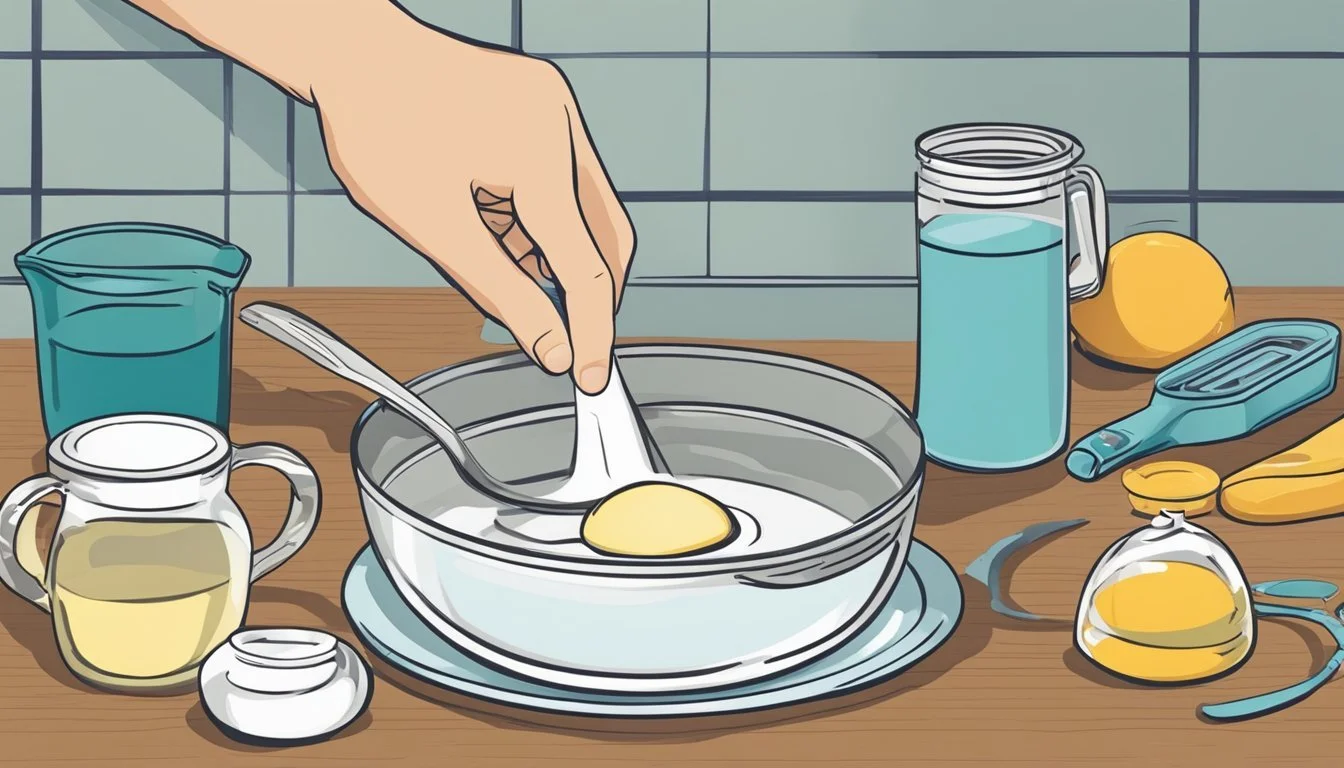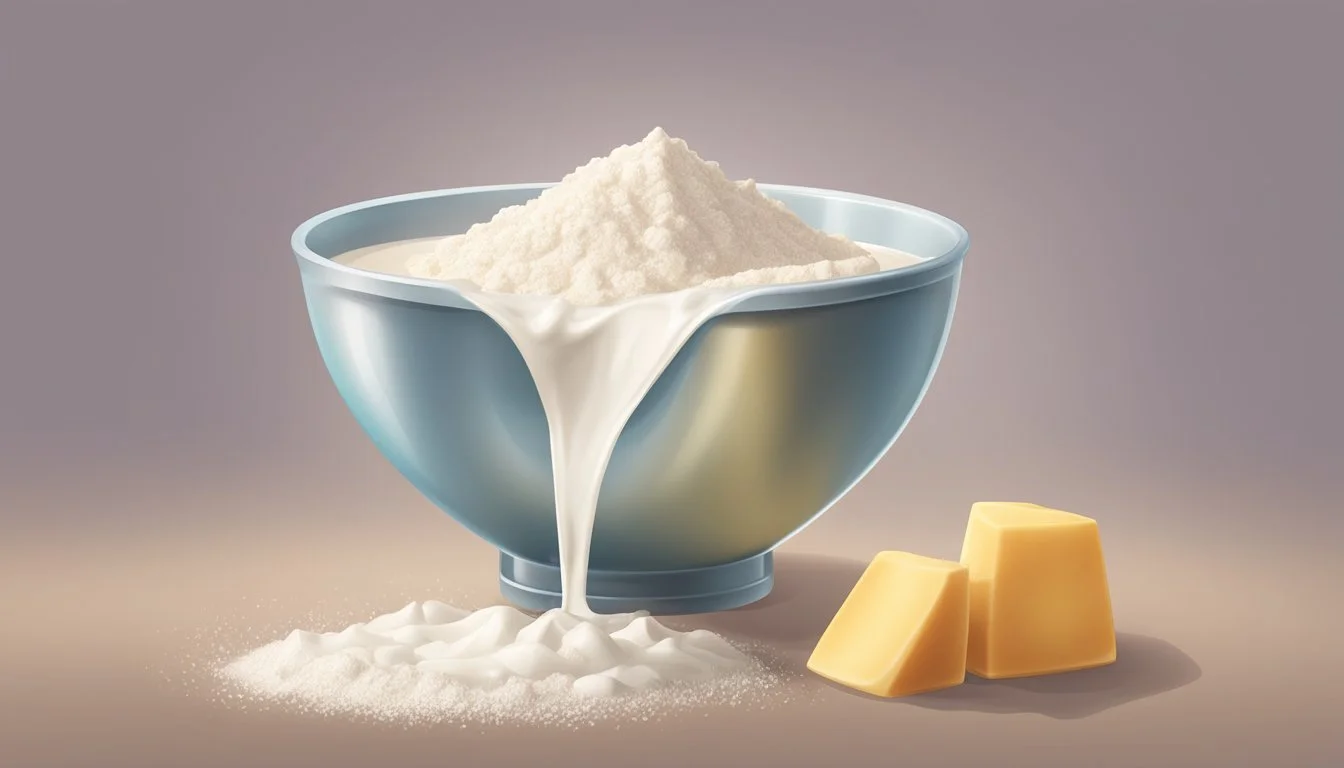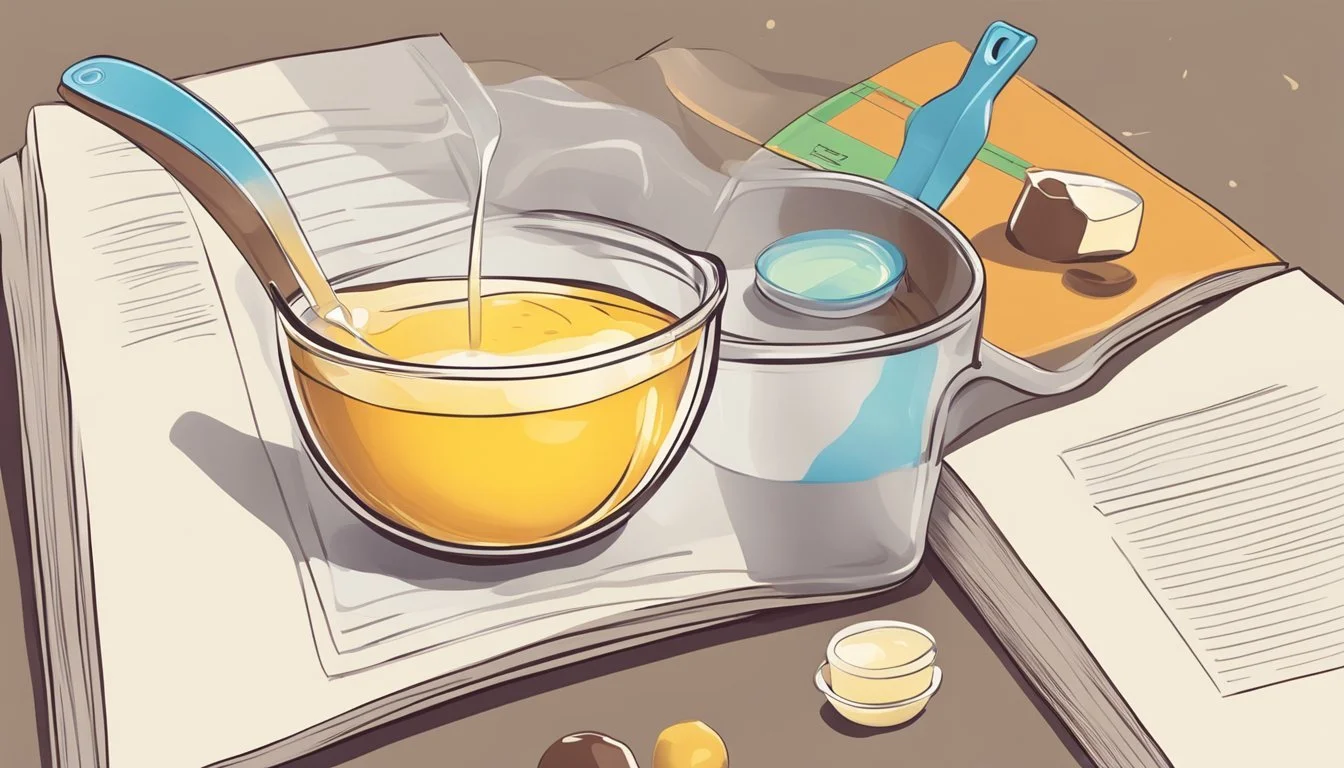How to Measure the Right Amount of Liquid
Perfecting Pudding Consistency
Measuring ingredients accurately is a fundamental part of successful pudding-making. Pudding recipes, as with most baking and cooking recipes, require precise amounts of liquid to achieve the desired texture and consistency. Too much liquid, and the pudding may be too runny; too little, and it could turn out too thick or fail to set properly.
Liquid measurements in pudding recipes often call for the use of liquid measuring cups, which are specifically designed to ensure that cooks can accurately gauge the volume of liquids such as milk, cream, or water. These tools come marked with measurements in both milliliters and fluid ounces, allowing for versatility across different recipe standards. It is important to fill the measuring cup to the desired level without going over or under, as even a small deviation can affect the outcome of the pudding.
For cooks aiming to create the perfect pudding, understanding the nuances of liquid measurement is crucial. The process includes the use of clear and graduated liquid measuring cups, and the correct technique involves reading the measurement at eye level to ensure liquids are measured at the meniscus—the curve seen at the top of the liquid. By taking these steps, they ensure the amount of liquid added to a pudding recipe fulfills its role in the dish’s texture and flavor, leading to the most delectable results.
Understanding Liquid Measurements
Accurate liquid measurements are essential for the consistency and success of any pudding recipe. Understanding the differences between measuring systems, the units involved, and the types of measuring cups can ensure precision in the kitchen.
Imperial vs. Metric System
The Imperial system, primarily used in the United States, includes units like teaspoons, tablespoons, fluid ounces, cups, pints, quarts, and gallons. In contrast, the Metric system is based on units such as milliliters (ml) and liters (L), which are commonly used internationally and in scientific communities. When following a pudding recipe, one must be aware of the measurement system employed and should use the appropriate tools for that system.
Units of Volume
Here is a brief conversion table for some common volume units in both systems:
Volume Unit Equivalent 1 tablespoon (Imperial) 3 teaspoons (Imperial) or about 15 milliliters (Metric) 1 fluid ounce (Imperial) 2 tablespoons (Imperial) or about 30 milliliters (Metric) 1 cup (Imperial) 8 fluid ounces (Imperial) or about 240 milliliters (Metric) 1 pint (Imperial) 2 cups (Imperial) or about 473 milliliters (Metric) 1 liter (Metric) 1000 milliliters (Metric) or about 4.22 cups (Imperial)
It is crucial to use exact amounts, as even slight deviations might alter the desired consistency of pudding.
Measuring Cup Types
There are two main types of measuring cups: liquid measuring cups and dry measuring cups. Liquid measuring cups are typically made of glass or plastic, with a spout for pouring and measurement markings in various units (cups, fluid ounces, milliliters) for accuracy. They allow for measuring to the correct line while looking at eye level. Dry measuring cups, on the other hand, are designed to be filled to the top and leveled off with a straight edge. For the most accurate liquid measurements in pudding preparation, one should always use liquid measuring cups.
Selecting the Right Measuring Tools
Accurate measurement of ingredients is critical for the success of any recipe, especially when preparing a pudding where the consistency and texture are key.
Measuring Cups and Spoons
Measuring cups and spoons are essential for obtaining the precise amount of liquid called for in pudding recipes. They come in various sizes, enabling the user to measure volumes ranging from a fraction of a teaspoon to several cups. For liquid ingredients, it is vital to use liquid measuring cups, which have a spout for pouring and are clear with markings to ensure liquids can be measured accurately at eye level.
Measuring Spoons: Typically used for smaller quantities under ¼ cup.
Liquid Measuring Cups: Best for volumes ¼ cup and over.
To use, fill the measure to the correct line without going over, and check at eye level.
Using a Kitchen Scale
For pudding recipes requiring precision, a kitchen scale can be an indispensable tool. It provides accuracy in measuring liquids by weight, which can be more reliable than volume measurements, particularly for denser liquids.
Precision: A kitchen scale can measure to the nearest gram or ounce.
Consistency: Ensures repeatability in results.
Place a container on the scale, tare to zero, and pour in the liquid until the correct weight is reached. This method is especially useful when converting volume measurements to weight (1 cup water weighs approximately 237 grams).
Preparing Ingredients for Measurement
Accurate measurement of ingredients is paramount to the success of a pudding recipe. Precision ensures the desired texture and flavor balance every time.
Dealing with Dry vs. Wet Ingredients
Dry Ingredients: When measuring dry ingredients like flour and sugar, one should use dry measuring cups that can be leveled off for precision. Ingredients such as packed brown sugar need to be pressed into the cup and leveled with a flat edge to ensure the correct amount. They mustn't be packed too loosely or too tightly. For flour, spooning it into the measuring cup and leveling it off without compacting it helps avoid adding too much.
Flour: Spoon and level
Sugar: Pour and level
Packed Brown Sugar: Press into the cup and level
Wet Ingredients: Wet ingredients like milk, whole milk, cream, and eggs require a different approach. They should be measured using liquid measuring cups with clear measurement markings. The cup should be placed on a flat surface, and the ingredient should be poured until it reaches the desired mark, checking at eye level for accuracy. Ingredients that are prone to settle, like milk or cream, need to be stirred before measurement to ensure uniformity.
Milk/Whole Milk: Stir, pour, and read at eye level
Cream: Same as milk; ensure consistency is uniform before measuring
Eggs: Crack and check for shell fragments before adding to the mix
By differentiating between the measurement methods of dry and wet ingredients, bakers can achieve the consistency and deliciousness that every pudding recipe deserves.
Measuring Techniques for Accuracy
Accurate measurements of liquid ingredients are crucial to achieve the desired consistency and taste in pudding recipes. Precision in both volume and weight can greatly affect baking results.
Leveling and Scooping
When measuring liquid for pudding, the cook should use clear measuring cups designed for liquid ingredients. To ensure accuracy, they must fill the cup to the correct mark and check the level at eye height. The liquid should be level with the desired volume mark. Consistent volume measurements are key, as even small discrepancies can affect the final texture of the pudding.
Fill the measuring cup to the brim
Check the measurement at eye level
The liquid's meniscus (curved surface) should align with measurement markings
Weighing for Consistency
For even greater precision, liquids can be measured by weight. Pudding recipes often benefit from the accuracy of using a digital scale, as this method accounts for variance in density among different ingredients. One should tare the scale with the container on it before adding the liquid. They should pour the liquid slowly until the scale reads the desired weight—grams or ounces—corresponding to the recipe's requirement.
Tare the scale with an empty container
Pour the liquid slowly, watching the scale
Aim for the precise weight as specified in the recipe (1 fluid ounce of water weights approximately 28.35 grams)
By carefully leveling, scooping, and weighing ingredients, a cook ensures that their pudding will have the same quality and texture every time.
Understanding Recipe Terms and Conversions
When following pudding recipes or any dessert preparation, it's crucial to understand the terminology and conversion methods between different measuring systems. This ensures the ingredients are measured accurately for consistent results.
Interpreting 'Cups' in Different Recipes
Recipes may specify measurements in 'cups,' a common unit in the cooking world. However, the standard cup size can differ between regions. In the U.S., 1 standard cup is 8 fluid ounces in the imperial system. Conversely, a metric cup, which is more common in the UK and other countries, is usually 250 mL. It's important to ensure that the correct cup measurement is used, especially when dealing with international recipes, as even a small discrepancy can alter the outcome of a pudding.
Volume to Weight Conversions
Many recipes require the conversion of liquid volumes to weights, which can be particularly important when dealing with ingredients for a pudding that require precision. Here's a simple table to help convert cups to both imperial and metric weight measures for water, which can be similarly applied to other liquids with a density close to water.
Volume Weight - Imperial Weight - Metric 1 teaspoon 0.17 ounces 4.93 grams 1 tablespoon 0.5 ounces 14.79 grams 1 cup 8 ounces 226.8 grams 2 cups 16 ounces (1 lb) 453.6 grams 4 cups 32 ounces (2 lbs) 907.2 grams
For non-liquid ingredients, densities vary, so the weight will differ from the conversions for water. Professional chefs might use specific conversion charts or scales for greater accuracy with these ingredients.
Using these conversions in context, if a recipe calls for a metric cup of milk for a pudding, one would measure out 250 mL, which is approximately equivalent to 8.8 ounces or just slightly above the 8 ounces of an imperial cup. The attentive cook should adjust the quantity correctly depending on the recipe's origin.
Mixing and Combining Ingredients
The perfect pudding is all about texture and flavor. Achieving a smooth and creamy batter is crucial, as well as adding ingredients in the right sequence to maximize the flavor profile.
Creating a Smooth Batter
To create a smooth batter, one should begin by sifting dry ingredients such as sugar, cocoa powder, and cornstarch to remove any lumps. This helps ensure an even texture. She then carefully incorporates the liquid ingredients.
Start by mixing a small amount of the measured liquid - typically milk or cream - into the dry mix to make a paste.
Gradually whisk in the remaining liquid in portions, smoothing out lumps as they form.
Continue to mix until the batter is homogeneous and silky.
A hand mixer or a whisk can be used for this process. It’s essential to mix enough to combine ingredients thoroughly but not so much as to incorporate too much air into the pudding.
Adding Ingredients Sequentially
Adding ingredients in the correct order is key to a flavorful result.
First, combine all the dry ingredients, which includes sugar and spices that contribute to the flavor base.
Next, slowly add your main liquid, generally milk or a mix of milk and cream, to the dry mixture.
For an enhanced taste, one can infuse the milk with vanilla or other flavorings beforehand and then strain it into the dry ingredients.
A typical sequence might look like this:
Combine sugar, salt, and cornstarch.
Gradually add milk to form a paste, then the rest of the milk.
Introduce flavorings like vanilla or chocolate.
By following these steps, one ensures that the flavor is well-distributed throughout the pudding. Each ingredient is given the opportunity to blend properly, promising a rich and appealing dessert.
Specific Pudding Considerations
When crafting the perfect pudding, precise measurement of liquids is pivotal to achieve the desired texture and consistency. Whether it's the fluffiness of a Yorkshire pudding or the smoothness of a custard, each type of pudding demands specific consideration.
Perfecting Yorkshire Pudding
To ensure Yorkshire pudding achieves its characteristic puff, the ratio of liquid to flour must be exact. Typically, for every cup of flour, one needs 1 cup of liquid, which is usually milk. The consistency should resemble heavy cream. It's crucial to allow the batter to rest so that the gluten relaxes, contributing to a lighter, airier result. Steam plays a vital role in the cooking process; thus, the oven should be preheated to a high temperature (usually between 425-450°F) to generate a rapid rise.
Ideal Ratio:
1 cup flour
1 cup liquid (milk)
Addressing Texture in Custard Puddings
For custard puddings, the amount of liquid used determines whether it will be firm or soft. The liquid typically involves milk or a combination of milk and cream. The beauty of custard lies in its smooth, creamy texture, which requires gentle cooking to prevent curdling. For a standard baked custard, the usual proportion is 2 to 3 eggs per cup of liquid. Cornstarch can be added to thicken and stabilize the custard, resulting in a baked texture that is simultaneously firm and velvety.
Custard Proportions:
Firm texture: 3 eggs per cup of milk
Soft texture: 2 eggs per cup of milk
Optional: Cornstarch to thicken
Both types of puddings rely heavily on the correct liquid measurement for successful execution.
Common Baking Ingredients and Additives
Baking a perfect pudding involves knowing how different ingredients interact and contribute to the final dessert. Precise measurements and correct choices can greatly influence the texture and flavor.
Role of Proteins and Sugars
Proteins, primarily found in eggs and milk, are essential for structure and firmness in puddings. When heated, proteins coagulate, giving the pudding its characteristic solidity. Sugars play a multifaceted role; they sweeten, create a pleasing texture, and can aid in browning. Granulated sugar is the most common, dissolving well within the mixture, whereas honey, an alternative sweetener, adds its distinct flavor and moisture-retaining properties.
Selecting Flavor Enhancers
Flavor enhancers like vanilla extract impart a warm, comforting note. Typically, one teaspoon can subtly elevate a standard pudding. Chocolate chips, on the other hand, introduce pockets of melted chocolate, providing intense flavor and a gooey texture upon melting. Baking ingredients like baking powder and baking soda are used sparingly as they can affect the texture without necessarily altering the taste. When it comes to salt, opting for kosher salt is preferable; its larger flakes distribute more evenly than table salt and can heighten the overall taste profile without overwhelming the sweetness.
Frequently Asked Questions
Can I use the same measuring cup for both liquids and dry ingredients?
No, one should not use the same measuring cup for both liquids and dry ingredients. Liquid measuring cups typically come with a spout and are meant to be filled to the top. Conversely, dry measuring cups are designed to be filled and leveled off.
How do I accurately measure liquid ingredients like vegetable oil or caramel sauce?
To measure liquid ingredients:
Place the liquid measuring cup on a level surface.
Pour the liquid slowly, stopping when it reaches the desired measurement line.
Verify the measurement with your eyes at eye level for precision.
What is the correct way to measure ingredients like beaten eggs?
For beaten eggs, it is appropriate to use a liquid measuring cup. One should lightly beat the eggs, then pour them into the measuring cup to the required line.
Is there a particular type of flour that should be used when the recipe calls for 'plain flour'?
When a recipe specifies 'plain flour,' it refers to all-purpose flour without raising agents. One should measure it using a dry measuring cup, spooning the flour into the cup and leveling off the excess.
When should I use American standard measurements or scale measurements?
For most American recipes, standard cup and spoon measurements are typical and expected. However, using a kitchen scale can greatly increase precision, especially for critical or large-quantity recipes where accuracy is paramount.
How do I ensure I'm measuring ingredients correctly when following a pudding recipe?
Accuracy in measuring ingredients is key. Here's what to keep in mind:
Liquids: Measure in a clear cup designed for liquids at eye level.
Dry ingredients: Spoon into a dry measuring cup and level off.
Eggs: Crack and lightly beat, then measure as a liquid.
Leaveners and small quantities: Use measuring spoons and level off.
Read the recipe fully before measuring to understand the specific requirements for each ingredient.






